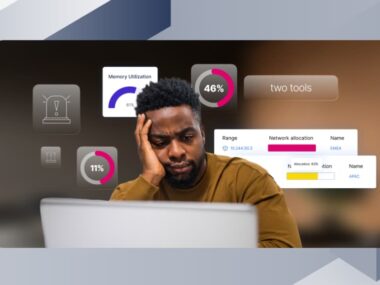Net Health CIO: Remedying health care IT is possible
Net Health CIO Jason James shares how he transforms health care IT by thinking like a politician and embracing the death of going to work at the office.

To change health care, we need to hire from outside of the industry.
That’s what Jason “JJ” James thought when he was first approached to be the CIO at Net Health. He’d been a disruptor his whole career, interested in next-gen tech and changing things up—not heading technology implementation in an industry known for its reluctance to evolve.
But James was exactly who Net Health, a cloud-based software company for health care, was looking for: a disruptor. Someone who sees the humans on the other side of technology. And someone who doesn’t come with the biases of the health care industry pre-programmed in them.
Joining host and BlueCat Chief Strategy Officer Andrew Wertkin during Season 2 of the Network Disrupted podcast, James shared his unique perspective on IT in the health care industry and how to go about culture change in a change-resistant organization.
James also outlined which early decisions helped position Net Health to more easily weather the mass shift to remote work brought on by the COVID-19 pandemic. And he offered his thoughts on “humanizing” IT to better support remote work and his predictions for the post-pandemic fate of the office (spoiler alert: we’re all probably not going back).
Pursue culture change like a politician
To James, digital transformation starts with cultural transformation. That transformation, he believes, begins with the C-suite. He credits much of his success to date to the fact that Net Health’s culture embraces positive change and innovation from the top down.
However, he also recognizes that it is human nature to avoid change. For those who are leading a solo march for change within their organizations, it can be difficult. His advice: Think of it like politics. You have to campaign for change and never let up on the message of how that change can provide value to the enterprise.
Another option he suggests for disrupting a resistant group is to hire from outside the group’s industry. Indeed, many of James’ executive-level peers at Net Health did not start in the healthcare industry. He credits that for the transformative environment he’s found himself in. The true disruption to healthcare, he thinks, will come from outside.
The pandemic as a remote work movement accelerant
The pandemic may seem like it completely upended productive work. However, those who are paying attention will see that that’s not what’s happening. Instead, James suggests, the pandemic is accelerating an existing movement to allow employees the freedom to work more flexibly.
Some CIOs who were already enabling flexible, remote work were better prepared for the sudden shift to it last year. As part of that group, Net Health transitioned quickly because James’ team already had many of the right processes in place to enable secure, productive work beyond the office.
Compared to the transformational CIO, the traditional CIO may not have been as ready for the shift. James says it’s because the traditional role of the CIO has been to focus squarely on technology—not the human aspects or outcomes.
Humanizing IT leads to positive outcomes
Just like Atlanta Housing Authority CIO Brian Benn knows that it’s not only about providing technology, James gives similar advice to CIOs. Don’t only monitor how your technology is working. Look at how it’s being used. What are employees requesting? What types of tools and accommodations are they asking for?
James champions this mandate of staying close to the user’s needs. He calls it the “humanization of IT”.
Part of humanizing IT also means using technology to help employees experience what they did when they were back at the office, if even just to a degree. Early on, James realized that Net Health staff were missing out on ‘water cooler’ moments. Consequently, he justified his team’s support of some initiatives that weren’t purely productivity-focused. Instead, they helped disparate team members to connect with each other like they would over coffee or at lunch.
James measured positive outcomes from this endeavor through increased productivity, interconnectivity, and communication. Employees bonded in a new and positive way.
No going back [to the office full-time]
We will no doubt return to the office eventually, but James sees more of a hybrid approach. He doesn’t think everyone will have to return all at once or as often as before—and that the open office is dead.
While a subset of professionals still associates office real estate with success (i.e., ‘the corner office’), the workforce is overwhelmingly trending towards the desire for freedom in how they work. For all its difficulty, the pandemic showed us that it’s more possible than we first imagined.
James, too, says he’s happiest in his home office and can’t stomach asking employees to do something he wouldn’t want to do himself. In this case, it’s returning to full-time, in-office work.
He predicts that offices will transform in response to this desire. It might be something more like a shared space that encourages hybrid work-from-home models. Or perhaps the office of the future will be purely a collaboration hub, where teams may gather in smaller numbers less frequently but more meaningfully. He also posits that employees will have more happy hours and longer lunches; events together will be more celebratory.
Ultimately, he says, “The office will have to evolve in a way where you’ll have to give somebody a reason to come back to the office.”




